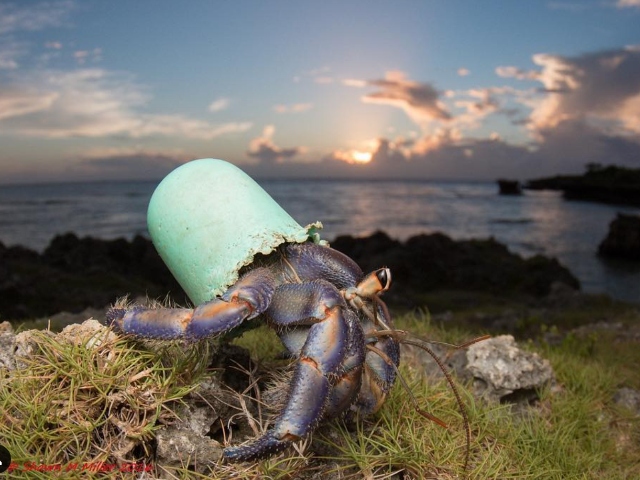
-
Even Hermit Crabs Are Turning Into Plastic, Choosing To Wear Bottle Caps Over Shells [Images]
01 Feb 2024 by Tayla in Animals, Conservation, Environment, Nature, World
[imagesource:instagram/maketheswitch4nature_]
All over the world, hermit crabs, who are naturally supposed to scavenge shells as armour for their bodies, are turning increasingly to plastic waste instead.
That is yet another devastating climate crisis reality to add to the docs.
Scientists have expressed how they were “heartbroken” to see the extent to which the animals were living in our rubbish, after an analysis of photos, taken by wildlife enthusiasts, and published in the journal Science of the Total Environment, has shown this growing trend among our ocean critters.
They said two-thirds of hermit crab species were pictured in “artificial shells”, which are all essentially things that humans have discarded, per the BBC:
The study used social media and photo-sharing websites, as one of the researchers Marta Szulkin, an urban ecologist from the University of Warsaw, explained: “We started to notice something completely out of the ordinary.
“Instead of being adorned with a beautiful snail shell, which is what we’re used to seeing – they would have a red plastic bottle cap on their back or piece of light bulb.”
Straws aside, any single-use plastic causes havoc, as you can see.
View this post on InstagramThe scientists found a total of 386 individuals using artificial shells – mainly plastic caps.
“According to our calculations, 10 out of the 16 species of land hermit crabs in the world use this type of shelter and it’s been observed in all tropical regions of the Earth,” Prof Szulkin explained.
It isn’t yet clear whether these materials are harmful – or perhaps even helpful – for the small, vulnerable crustaceans.
“When I first saw these pictures, I felt it was heart-breaking,” Prof Szulkin told BBC Radio 4’s Inside Science. “At the same time, I think we really need to understand the fact that we are living in a different era and animals are making use of what is available to them.”
There is certainly a great deal of plastic in the marine environment for the animals to choose from. A recent study that attempted to quantify the scale of plastic pollution estimated that at least 171 trillion pieces of plastic are now floating in our oceans.
That could nearly triple by 2040 if no action is taken on this plastic scourge, experts have warned. While we might learn from the tiny crustaceans about reusing waste, the sad reality remains that microplastics now contaminate the entire planet, from the summit of Mount Everest to the deepest oceans.
Studies have shown that we humans are being infected by plastic bits, per The Guardian:
Microplastic pollution has been detected in human blood for the first time, with scientists finding the tiny particles in almost 80% of the people tested.
Plastic particles have also been found in the placentas of pregnant women, and have been found to travel around the body, possibly lodging in organs. Researchers are concerned as microplastics cause damage to human cells in the laboratory and air pollution particles are already known to enter the body and cause millions of early deaths a year.
“The big question is what is happening in our body?” Prof Dick Vethaak, an ecotoxicologist at Vrije Universiteit Amsterdam in the Netherlands, said.
“Are the particles retained in the body? Are they transported to certain organs, such as getting past the blood-brain barrier?” And are these levels sufficiently high to trigger disease? We urgently need to fund further research so we can find out.”
A new review paper published on Tuesday, co-authored by Vethaak, assessed cancer risk and concluded:
“More detailed research on how micro- and nano-plastics affect the structures and processes of the human body, and whether and how they can transform cells and induce carcinogenesis, is urgently needed, particularly in light of the exponential increase in plastic production. The problem is becoming more urgent with each day.”
The bottom line is that there is risk in all things plastic, from drinking from plastic-lined coffee cups, and plastic PET water bottles, wearing a plastic face mask, feeding babies with plastic bottles, and using plastic carrier bags to name a few.
Latest News
-
Game, Seth, Match – Goodbye 2024
Hey Guys - thought I’d just give a quick reach-around and say a big thank you to our rea...
-
Breakfast Of Champions: Hollywoodbets Kenilworth Racecourse Breakfast Gallops Is Back!
[imagesource:CapeRacing] For a unique breakfast experience combining the thrill of hors...
-
Need NYE Plans? Cafe Caprice’s Night Of Enchantment Masquerade Party Could Do The Trick
[imagesource:howler] If you're still stumped about what to do to ring in the new year -...
-
Buckingham Palace Steps In After Staff Christmas Party Spirals Out Of Control
[imagesource:maxandeli/facebook] It's not just in corporate that staff parties get a li...
-
Designer Babies Are Running Into Trouble As Teens, Grappling With Being ‘Experiments’
[imagesource:here] Imagine being born with the weight of your parents’ version of per...
-






























